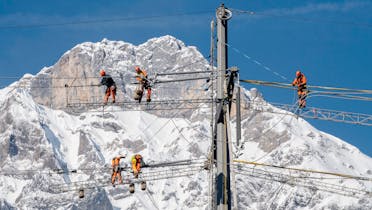
Cows now graze on lush, green grass in meadows where pylons once stood. Before the areas in the Uri valley floor were approved for normal use, Swissgrid carried out extensive soil remediation at the former pylon sites – even going further than required by the law and regulations.
Until a few years ago, two extra-high-voltage lines ran parallel along the Uri valley floor. One of them belonged to Swissgrid and served as an important north-south axis for the transfer of electricity. The other was used by SBB for railway operations. In 2018, the two partners combined both these lines on the section between Attinghausen and Altdorf Nord onto a common route that runs parallel to the motorway and the banks of the Reuss. After bundling the infrastructure, it was possible to dismantle the two old lines. During the disassembly process, the soil was remediated and returned to its original state.
A guest article by Marzio Giamboni, Project Manager at Hintermann & Weber AG
To prevent corrosion, pylons on power lines are given a protective coating. In the past, products were used that contained environmentally hazardous substances. As the old protective layer decomposes over the years due to weathering, pollutants such as lead, zinc and PCBs can enter the soil along with smaller quantities of chromium and cadmium.
31 pylons from the 1950s were dismantled as part of the Eyschachen line consolidation project. Most of the places where pylons were disassembled were on agricultural land.
During the project approval process, the canton of Uri and Swissgrid agreed that the soil around all the pylon sites on agricultural land would be remediated to remove pollutants, irrespective of the extent of exposure to environmentally hazardous substances. The remediation measures defined in the project went far beyond those required by the Environmental Protection Act or the Federal Ordinance on Soil Pollution.
Valuable soil for agriculture
A large proportion of the sites are located in crop rotation areas which represent some of the best agricultural land in Switzerland and are subject to special protection regulations. In times of crisis, they ensure Switzerland’s food supply. Thanks to the remediation measures, Swissgrid was able to restore the quality of these areas and return them to the landowners in their original condition.
In-depth investigations were necessary in order to find out how heavily the soil was contaminated with pollutants. We carried out soil analyses at six selected pylon sites. At a distance of one metre from each pylon foundation, samples were taken in all four main directions and examined in a laboratory. On average, the soil remediation covered a radius of approximately 15 metres around the pylon foundations, where we replaced the soil to a depth of up to 80 cm. We measured the individual surfaces with a mobile X-ray machine to ensure that all pollutants were removed.
Not all soil is the same
We had to find around 4,000 m3 of clean soil material to replace the contaminated soil. It could not just be any old material; it had to be quite specific soil that would meet the demands of an agricultural crop rotation area. Our search took us to all ongoing construction sites in the canton of Uri as well as beyond the cantonal border. We were offered a large quantity of soil material, but only a few sites were suitable for our project. In the end, we were able to obtain appropriate material from six different construction sites in the Uri valley floor and from a construction site in the canton of Lucerne.
Objective achieved thanks to patience and good listening
Newly laid soil must rest for a while and be cultivated gently so that it can develop favourable properties for agriculture at its new location (subsequent soil management). The farmers concerned had to respect a three-year period of gentle cultivation in accordance with soil protection requirements. The relevant areas were not allowed to be grazed on or fertilised, for example. The affected farms received remuneration in exchange. We checked compliance twice a year on site and discussed cultivation measures with the farmers. During these inspections, we also examined whether the soil at the rehabilitated sites was developing well. In the vast majority of cases, the cultivation requirements were being met, which meant that after three years of special management, we were able to approve the areas for normal use in consultation with the cantonal soil protection agency.
The remediation of the soil in the Uri valley floor was a great challenge for us as environmental site monitors. Determining the contamination levels and obtaining the clean soil material was very time consuming. Our aim was to ensure that the farmers were satisfied with the remediation process. This required good communication and a sympathetic ear to listen to the concerns of all the parties concerned.








